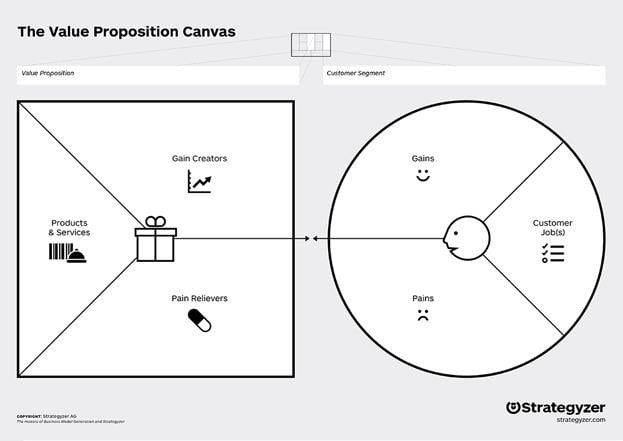[lwptoc]
Separating yourself from the competition is critically important and therefore deep diving in this section is essential.
In the Lean Canvas section we discussed the importance of your unique value proposition. Your value proposition is so important, that it has its own canvas, aptly named The Value Proposition Canvas which I will discuss toward the end of this section. But first, a fundamental overview:
When creating your UVP, avoid listing ambiguous statements here such as “superior customer service” or “cool brand” or the “our product is the best”. Instead use a clear benefit that the customer can easily measure.
My favourite UVP is: “Fresh, hot pizza delivered in 30 minutes or less, guaranteed”. As you can see, Domino’s UVP is a statement that communicates its value to the customer and further indicates why you should do business with Dominos. In doing so, you could say it indicates why you shouldn’t do business with the competition.
Before you create a value proposition, focus on your audience. Ensure you know what is important to them and what their pain points are. Domino’s discovered that people’s main pain points when ordering pizza was two-fold. Their target audience hated ordering pizza that was arrived cold and disliked the uncertainty of when their pizza would arrive. Dominos modelled their UVP around those two pain points.
Dominos also tied a measurable outcome that was bolstered with a guarantee. Which means they wore the risk of not keeping their promise of delivering a hot pizza in 30 minutes. This strategy was ingenious because it boosted customer satisfaction.
When developing your UVP, you should aim for simplicity and clarity. Below are some other tips to help you define a great UVP.
 Make it Memorable
Make it Memorable
When your target market read your UVP, it should surprise them with the incredible benefit you promise to deliver. This will cause your audience to form a clear picture of the what they get when they deal with you.
Address the Pain Points Of The Target Market
Be sure to communicate your benefits in your UVP that directly address their pain points. People want specificity, they want speed and value for money. Dominos directly address their customers’ pain by promising to deliver within 30 minutes it solves the problem (scratches the itch) of the customer.
Mind Your Language
Your UVP should use plain English. Be clear and to the point. This helps to connect with your audience and makes your startup more relevant to your audience. If you are in a niche industry, use familiar industry terms. Engage in forums, infiltrate Facebook groups, and join the conversation.
Testing Your UVP
Put your value proposition side to side with your competitors’ – if they have one. Which one of these would you pick? If so, what can be improved? If you’re objective, this approach can be helpful. However, if you shortlist a few UVP’s that you create, you can take it to a survey, so your target audience can decide.
Other Great UVP’s
You have heard me talk about Domino’s UVP (more than once!). However, there are other great examples, such as LastPass. This software company’s UVP also doubles as a great headline: “simplify your life, LastPass remembers all your passwords, so you don’t have to”. This UVP focuses on avoiding the pain point of forgetting numerous passwords we all have. It also clearly states what their solution does and the benefit the user receives.
Lightshot is another company with an effective UVP “the fastest way to take a customizable screenshot”. It is easy to understand what it is and the value you receive.
Take your time with your team and develop a great UVP. When you have people’s attention, it is important to communicate what your product does and the benefit your target audience gets.
Using the Value Proposition Canvas
The Value Proposition Canvas is a tool initially developed by Dr
Alexander Osterwalder. This canvas helps map the customer needs and values to the product. The Value Proposition Canvas has two sections named customer segment and value proposition, which relate to the same sections in the Lean Canvas. Completing this canvas, will assist you to complete those two sections in the Lean Canvas more accurately.

The value proposition section on the left, identifies your relevant products and services. It is fine if you have one core product to begin with. The gain creators are features of your product or service that creates the benefits you have identified in the customer segment. Pain relievers display the features of your product or service that takes your target market’s pain away.
In the customer segment section on the right, you will need to add your customers’ gains, pains, and jobs. The jobs are tasks that your customer is involved in. And the gains are the benefits your customer desires when performing those tasks. Similarly, the pains are frustrations or problems your customers face when performing those jobs.
Now that you established both blocks, you will need to map the Gains to the Gain Creators and the Pains to the Pain Relievers. You will need to rank those items in order of importance in the effort to keep the essential features. You will have a perfect fit when the services/products a part of the value proposition will address the pains and gains from the customer profile. Once you identify this, you will have to validate what’s important to customers and then acquire their feedback on the value proposition. This will help refine the value proposition until you make it perfect.
As you can see, creating a value proposition is all about what customers want and expect from you. Get to work and get it down on paper. As you go through this exercise with your team, it is likely that you will identify that further research is required to get inside your customers’ heads to uncover their pain points.
 Make it Memorable
Make it Memorable The value proposition section on the left, identifies your relevant products and services. It is fine if you have one core product to begin with. The gain creators are features of your product or service that creates the benefits you have identified in the customer segment. Pain relievers display the features of your product or service that takes your target market’s pain away.
In the customer segment section on the right, you will need to add your customers’ gains, pains, and jobs. The jobs are tasks that your customer is involved in. And the gains are the benefits your customer desires when performing those tasks. Similarly, the pains are frustrations or problems your customers face when performing those jobs.
Now that you established both blocks, you will need to map the Gains to the Gain Creators and the Pains to the Pain Relievers. You will need to rank those items in order of importance in the effort to keep the essential features. You will have a perfect fit when the services/products a part of the value proposition will address the pains and gains from the customer profile. Once you identify this, you will have to validate what’s important to customers and then acquire their feedback on the value proposition. This will help refine the value proposition until you make it perfect.
As you can see, creating a value proposition is all about what customers want and expect from you. Get to work and get it down on paper. As you go through this exercise with your team, it is likely that you will identify that further research is required to get inside your customers’ heads to uncover their pain points.
The value proposition section on the left, identifies your relevant products and services. It is fine if you have one core product to begin with. The gain creators are features of your product or service that creates the benefits you have identified in the customer segment. Pain relievers display the features of your product or service that takes your target market’s pain away.
In the customer segment section on the right, you will need to add your customers’ gains, pains, and jobs. The jobs are tasks that your customer is involved in. And the gains are the benefits your customer desires when performing those tasks. Similarly, the pains are frustrations or problems your customers face when performing those jobs.
Now that you established both blocks, you will need to map the Gains to the Gain Creators and the Pains to the Pain Relievers. You will need to rank those items in order of importance in the effort to keep the essential features. You will have a perfect fit when the services/products a part of the value proposition will address the pains and gains from the customer profile. Once you identify this, you will have to validate what’s important to customers and then acquire their feedback on the value proposition. This will help refine the value proposition until you make it perfect.
As you can see, creating a value proposition is all about what customers want and expect from you. Get to work and get it down on paper. As you go through this exercise with your team, it is likely that you will identify that further research is required to get inside your customers’ heads to uncover their pain points.
